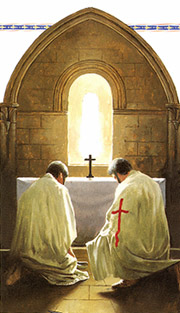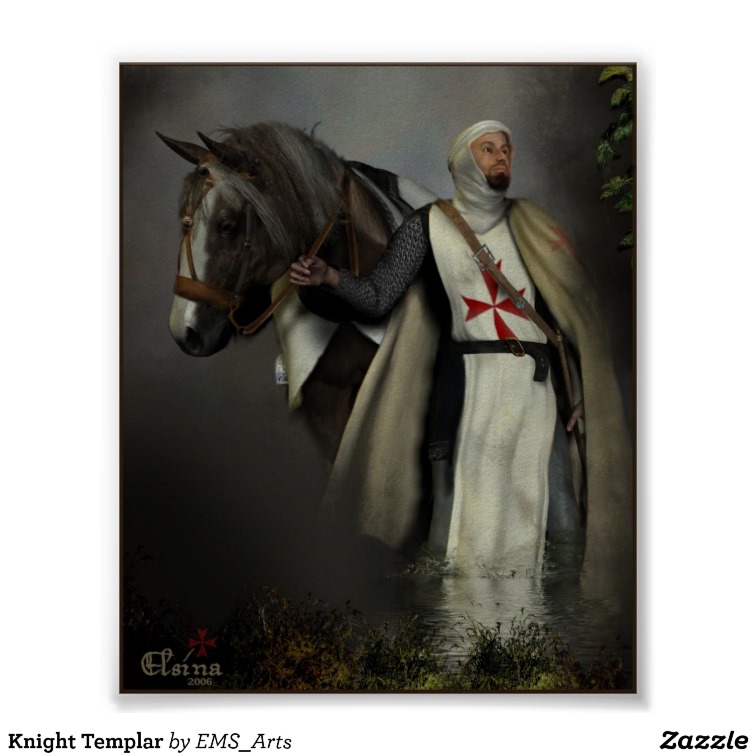
The Knights Templar
BEFORE THE CRUSADES:
Jerusalem is situated in a mountainous place, lacking streams, woods, and springs; except for the spring at Siloam. Jerusalem was a place of pilgrimage since the dawn of Christianity.
The Crusades were a long-term result of the rise of Islam. The Islamic religion began to sweep into Europe and was at the threshold of conquering all of Europe. The First Crusade was primarily launched to safeguard the pilgrim routes to Jerusalem and to save the holy places of Christianity from the invasion of Seljuk Turks. But there were also political motives. It was in the interest of the Pope and the Normans to assist the weak Byzantium emperor in Constantinople in the hope of uniting the eastern and western branches of the Christian Church.
The first organized group of knights who protected pilgrims traveling to the Holy Lands, were the Knights Templar. The Knights Templar of Jerusalem were the guardians of the Sangreal (or Holy Grail). They were influenced by Gnostic and Sufu doctrines. The Knight was much like an old western gunslinger: he rides into town and fights for the good of the people, then leaves town alone (Johnson, Kenneth and Marguerite Elsbeth, The Grail Castle: Male Myths and Mysteries in the Celtic Tradition. St Paul: Llewellyn Publications, 1995).
Legends say that the origins of Freemasonry stem back to the Knights Templar. This, of course, involved architecture, not crusades. The Temple of Solomon is the link. This temple was built by the Jewish and Tyrians. Freemasonry will be discussed later. My emphasis to this point, is on the Payen name, which may or may not connect to my own ancestry.
Written and researched by Margaret [nee Knight] Sypniewska, B.F.A.Before the Crusades, Holy Men were to distain war:
WHY DID THE CRUSADES TAKE PLACE?
 ... ...
 |
The Templar Seal showing two knights (Hugh de Payens and Godefroi Saint Omer) on one horse |
HUGH DE PAYENS AND THE KNIGHTS TEMPLAR:

|
Sir Hugh de Pagen (Payens) was a French (noble) knight from Champagne. He was thought to have been a man of deep religious values, humility, and valor. Hugh was married to Catherine St. Clair, and after her death he took his religious vows (Wasserman, James. The Templars and the Assassins: The Militia of Heaven. Rochester, Vermont: Inner Traditions, 2001, 156). Hugh was nearly fifty (50) years of age, when he founded the Order of the Poor Knights of The Temple of Solomon (The Knights Templar). Hugh was a veteran of the First Crusade (in 1099) and had spent twenty-two years of his life east of Europe. In 1118/1119, "Hughes and eight other knights, took vows of obedience to Warmund of Picquigny, the Patriarch of Jerusalem, resolving to live in holy poverty and charity, and to devote themselves to the care and protection of Christian pilgrims..." (ibid). The Templars were given lodgings in the al-Aqsa mosque near the Dome of the Rock, which was thought to have been the original site of the Temple of Solomon. The Templars were founded in 1118, and were dedicated to the survival of both the pilgrims and Christendom in the Holy Lands. The first Templar preceptory outside the Holy Land was built on the St. Clair/Sinclair Estate in Scotland. Hugues (Hugh) de Payens was a cousin and vassal of the Comte de Champayne. The first crusade resulted in the fall of Jerusalem, and established the Christian states of Jerusalem, Antoich, Tripoli, and Edessa. About 3,000 knights set out from Constantinople with 12,000 infantry. Hugh and Godfrey St. Omer founded the Order of the Templars of the Cross, which gained great size and power during the Middle Ages. He (Hugh) was sent by Baldwin II of Palestine as envoy to the Kings of France and England, and he was a famous crusader. In Robert Payne's book, The Dream of the Tomb: A History of the Crusades, it states that Hugh appeared to have been sweet-tempered, totally dedicated, and ruthless on behalf of the faith. The Knights Templar were Soldiers of Christ, ascetic almost to fanaticism, single-minded to the exclusion of all ideas except the worship of God and the annihilation of the Saracens (125). Even though Christ had urged his followers not to kill, the Templars were now to kill in his name. St Bernard decided that killing infidels was not to be considered homicide, but malicide (the killing of evil). The Templars were to safeguard the lives of pilgrims who flocked to Jerusalem and other holy places. They were armed monks, priestly swordbearers, chivalrous only on behalf of God, and shock troops to fight righteous battles. Their courage was legendary. Saewulf wrote: The Saracens lie in the mountain caves to surprise Christians ... Saewulf, with his Anglo-Saxon companions, arrived at a time when the King of Jerusalem was first established. Hundreds died before they saw Jerusalem's golden gates. |
|
"Hugh de Payens infused the Templars with the energy of chastity and obedience. No women might enter the Temple; they were not permitted to embrace any woman, not even their sisters or their mothers. A lamp burned in their dormitories all night; their breeches were tightly laced, they were never permitted to see each other naked. They were permitted no privacy, and letters addressed to individual Templars had to be read aloud in the presence of the Grand Master or a chaplain. They never shaved their beards. Their Spartan lives were directed toward the single end of protecting the pilgrims and the Kingdom of Jerusalem by killing the enemy" (Payne 126). The Muslims both feared and respected the Templars, and at times, they went to Muslim court as diplomats.
In 1120, Fulk V, Comte (Count) de Anjou (father of Geoffrey Plantagenet) was said to have joined the Knights Templar Order, and he was followed in 1124 by Hugues, Comte de Champayne. These knights were evidently far from poor, and there is no record of these illustrious noblemen policing the Bedouin-infested highways for the benefit of pilgrims. Perhaps they were given Order status as patrons? St Bernard was related to the Comte de Champayne and through him (also) to Hugues de Payens. Henri de St. Clair (11th century) was a crusader with Godefroi de Bouillon. His descendant (two centuries later) also a Henri, was the Commander of the Knights Templar at the Battle of Bannockburn. The Sinclairs had Viking heritage through both the Dukes of Normandy and the Jarls (Earls) of Orkney. Henry de St. Clair, son of Henri the crusader, was a Privy Councillor. His sister Richilde married into the Chaument family (also kin to Hugh de Payens ("Scotland and the Holy Grail" (295-297) in Highlander magazine).
Hugh was the Grand Master of the Knights Templar from 1118-1136, Hugh and many Templars learned to speak Arabic and other local languages, making them easy diplomats. In many ways, the Templars also appreciated the Muslim's religious devotion.
Hugh's eldest brother, Edmund de Pagen inherited all the family wealth, as the younger, Hugh was landless. Hugh decided that the Crusades promised adventure and
| 
|

|
This knight's coat of arms belonged to Sir Edward, Sir Edmund, and John Pagenham from Suffolk, England. I have yet to figure out how these knights might relate to Hugh (if at all). The records from this time period are difficult at best.
I found another name Pagendarm, in Norman, |
Hugh de Payens was also known as "Pagamus," a Burgundian knight. Burgundy is on the continent. Payens and Payns seem to be interchanged in records.
The Payens (Pagens), changed their name to "Payne," then "Paine." They moved to England (from Normandy, as a departure point) during the time of Edward the Confessor. In 1066, Pagen was listed as having land in sixteen counties in England.
Although Edmund de Pagen inherited wealth. Hugh was the famous brother, who later acquired his own wealth, and fathered a line of knights, Earls, and landowners (as told by family histories). Part of this line eventually came to the Americas.
The Templars eventually had property established in Francia, Provence, Iberia, and England. In the 13th century, they had properties in Germany, Dalmatia, and Morea.
Hinde also mentions Thetford, Norfolk County, England's most famous son, Thomas Paine who wrote the Rights of Man. Thomas was born in 1737 and was unrecognized until recently. He resided in "Green Gables."
***Recent discoveries, in regards to the PAYNE/Paine family has brought up a debate over their ancestry in America going back to peerage or yeoman class. There are two schools of thought. I will add that debate on my Paine page.

TEMPLAR LINKS:
TEMPLAR GEAR:
The Templar History website Templar History
SOURCES:
Bartlett, W.B. God Wills It. UK: Sutton Publishing, 1999.
Gardner, Lawrence. Holy Grail. New York: Barnes & Noble Books, 1996.
La Croix, Paul and Walter Clifford Meller. The Medieval Warrior. New York: BCL Press, 2002.
Reston, Jr., James. Warriors of God. New York: Doubleday, 2001.
Templar Shield, Templar tunic, and Sword from the movie, Kingdom of Heaven called the Sword of Ibelin.
Last updated December 6, 2017
